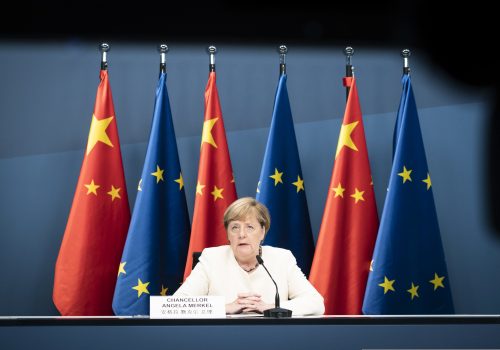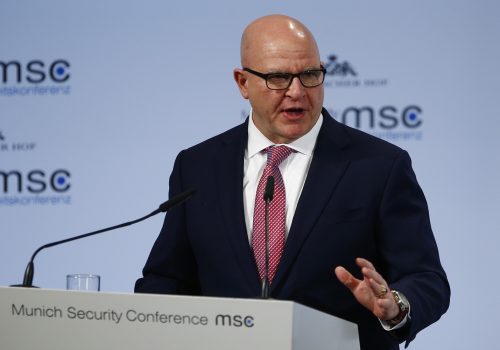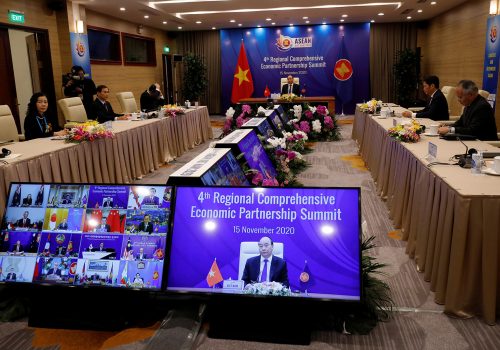“The early bird gets the worm” is not just an empty phrase. In economics, “first-mover advantage” refers to how a company can gain distinct advantages by being the first to establish itself in a new market. But an early move also generates temporary opportunities for competitors: the second-mover advantage.
In the 21st century geopolitical contest, the Chinese Communist Party has taken the first move by making clear strategic decisions, establishing distinctive goals, and broadcasting its intentions. These first steps, designed to establish regional ascendancy and place the People’s Republic of China (PRC) on the path to set the rules of global commerce and politics, have opened a window for the United States and its allies to take advantage of moving second.
In this narrow window of opportunity, the democratic community can take decisive steps to stem the rise of China’s autocratic influence and reinforce the democratic-led rules-based system. By increasing and accelerating economic decoupling with the PRC, promptly pursuing technological research and development to maintain advantage in the security and telecommunications spaces, and building closer regional multilateral relationships, democracies, led by the United States, can effectively counter Chinese efforts to reshape the global landscape. US leaders need to act quickly before their window closes. Though Chinese initiative has upset the status quo, their first move clarifies their vulnerabilities and exposes potential effective counterweights. By acting promptly to exploit these opportunities, the United States can take the second-mover advantage.
The PRC is its own worst enemy
Over the years, countries around the world have realized that the PRC threatens more than just the United States’ global influence. Increasingly, the PRC’s neighbors and economic partners are recognizing that the long-term aspirations of the Xi government stand to destabilize the broader economic order, impede the pursuit of their own economic development goals, and threaten their national sovereignty. There is a new consensus that fewer links with the PRC may be better than the status quo.
The COVID-19 pandemic has driven this point home. Broad belief that the PRC was not wholly transparent about the virus’ origin nor sufficiently communicative about the gravity of its threat, along with widely-held suspicions that the PRC manipulated the World Health Organization’s initial response, have painted the PRC as this pandemic’s chief villain.
Similarly, the predatory aspects of the Belt and Road Initiative are beginning to impact the perception of China amongst many of its erstwhile partners. The underwhelming economic payoff of PRC partnership on infrastructure projects appears increasingly to be a domestic political letdown for host nations. Poor-quality construction is resulting in dramatically shortened infrastructure lifecycles and far less than promised economic benefits. Moreover, Chinese firms increasingly favor importing labor and technical expertise for these projects, rather than creating jobs in their partner countries.
The credit arrangements associated with these investments often serve to benefit only the Chinese. Debt-trap diplomacy impels cash-strapped borrowers to default and turn over control of infrastructure to the PRC, as with the Sri Lankan Port of Hambantota in 2017. Increasingly, Chinese investment appears to look like at best a bad deal and at worst a trick made in bad faith.
Continued authoritarian behavior on the part of the Chinese Communist Party at home—whether with respect to the ethnic Uighur population, the citizens of Hong Kong, or the harassment of ethnic Chinese citizens of other nations—is undermining China’s footing with nations in the region and across the globe. The latest showdown between the Xi government and Australia over the treatment of Australian journalists and condemnation of the PRC for human rights violations at the UN are only two examples of this emerging trend.
Most disturbingly however, Chinese bellicosity over issues that it perceives to be core to national objectives are spreading the perception that a rising China is not a peaceful one. Continued militarization and overfishing by the PRC in the South China Sea are alienating the region. This shift is exemplified by the notable change in the Philippine government’s stance toward China as expressed in President Rodrigo Duterte’s September speech at the UN. Disputes in border regions with India and sabre rattling over US envoy visits to Taiwan similarly serve to encourage China’s neighbors to consider distancing themselves from the PRC. Forced to choose whom they trust as the arbiter of world affairs, many nations are finding a rules-based order led by the United States is much more reliable than one based on the interests of the PRC.
Finally, the above concerns have shifted US attitudes toward China. The past six months have seen a new consensus across the political aisle as leadership in both parties openly identify the PRC as a malign competitor to the United States. This is compounded by increasing public awareness of Chinese efforts to use espionage to steal US military and industrial secrets and to peddle influence in US domestic politics. All told, the result is increasing bipartisan support for a deliberate, aggressive approach to competing with the Chinese; the time for the United States to enact policy change has come.
The Chinese first move articulated their ambitions in statements and policies such as “China Dream” and China 2049. The PRC has demonstrated an intent to expand their influence through military and economic means, seizing or building islands across the South China Sea and buying increased access in developing nations with economic investment. By developing disruptive military technologies focused on thwarting the United States’ ability to project power and simultaneously investing in military technologies to match US capabilities, the PRC has telegraphed both method and intent to challenge the current balance of power.
These indicators frame the new security environment and expose weaknesses in the PRC’s position. The fruition of China’s first move is driving an alignment of interests in the Indo-Pacific and across the US political strata that make prompt action imperative. Now is the time to form an effective counter strategy and maximize the second-mover advantage.
How to take the second-mover advantage:
#1. Continue decoupling US economic interests from the People’s Republic of China and set up the United States and its allies and partners for long-term economic growth.
In addition to making its supply chains more independent, the United States must also ensure that allies and partners are afforded the opportunity to reduce their dependence on the PRC. Incentivizing US companies to re-shore through trade policy must also incentivize moving enterprises to strategic partners throughout the region.
US efforts to balance Chinese soft and sharp power should include increased foreign investment in key nations with specific attention paid to strategic partnerships that accentuate the US ability to compete in both economic and non-economic areas. Deliberate attraction strategies for India, Indonesia, and Thailand for example, stand to enhance the US military position in the region and directly counter Chinese efforts to expand its influence. Investing in regional physical infrastructure can generate access to foreign markets and diversify supply chains for critical technology such as semi-conductors.
As part of this effort, the United States and its allies and partners must also seek to address PRC violations of fair-trade practices, using tariffs and prohibitions on trade. Industries deemed critical to US security considerations and areas where the trade practices of the PRC are patently hostile or unfair should be treated as competitive space to be defended aggressively. Likewise, punitive measures to discourage intellectual property theft and illegal or coercive technology transfer stand to demonstrate US resolve not to tolerate abusive economic behavior. To be successful, these measures must address the concerns of allies and partners as well.
#2. Increase investment in the research and development of disruptive technologies and ideas
The United States currently enjoys an innovation lead over the PRC, as well as in key technology sectors. However, China is closing those leads through massive state investment in multiple industries in conjunction with industrial espionage, most visibly in telecommunications with respect to 5G, but also in bio-tech, data collection, artificial intelligence, and defense (specifically hypersonic weapons and stealth).
The United States must leverage the advantages inherent in its open markets through targeted investment in emerging technologies research and development. This should mirror efforts such as the Creating Helpful Incentives to Produce Semiconductors for America Act (CHIPS), but will require an increase in scale, as well as a broadening of the scope across the science, technology, engineering, and math (STEM) spectrum. Likewise, US immigration policies must continue to support the transfer of the world’s most creative and innovative thinkers to the United States through talent sensitive structuring. The United States has enjoyed the benefits of a global brain drain for decades; US law should continue to support the smooth assimilation of the most forward thinkers into US society.
Efforts in government modernization and efficiency must continue and be considered through the paradigm of great-power competition. Departments should foster creativity, eliminate red tape for project development, and reduce barriers to entry for competition where government policy intersects with US industry. This will allow a more agile and streamlined government to adjust resources and ensure investment in our future. The Department of Defense is a model for this process, with multiple services undergoing doctrinal reconsiderations, attempting to streamline the research and development to procurement processes, and charting specific courses for force design and development that will modernize the military for competition.
#3. Expanding military cooperation through enhanced multilateral security agreements, ensuring presence as a deterrent.
To counter the revisionist and coercive policies of the PRC, there is no substitute for physical presence. While US Navy plans to expand its number of ships in order to maintain the current balance of power on the open oceans is the correct first step, the time for development and deployment highlights the risks associated with over reliance on US hard power. To mitigate these risks, the United States must continue to build its alliances in the Indo-Pacific region.
An expansion of existing bilateral security agreements into a more comprehensive multilateral arrangement, perhaps based off of the Quad (United States, Japan, India, Australia) and likely including others, can dramatically alter the strategic balance within the Indo-Pacific. This type of arrangement, loosely modeled after NATO, will alter the calculus of any security-related PRC decision and serve to discourage further Chinese encroachment on its neighbors’ sovereignty and territorial claims. It will also provide access to additional basing options and, through increased interoperability training, for rapidly generating a larger force to balance against Chinese military expansion.
These steps will fundamentally alter the security picture in the region in favor of democracies and provide impetus to increase US commercial relationships. This reinforces the decoupling and research efforts and builds confidence in allied governments that the United States remains a trusted partner, as nothing says “we mean business” quite like a security guarantee.
The time to move has come
The situation is ripe for renewed US engagement. With emphasis on multilateral cooperation, economic fair play, and security underwritten by US presence, the United States can effectively compete with the Chinese and ensure that the relative peace and consistent economic growth of the past three decades continues and that the destabilizing authoritarian approach of the PRC will not dominate the commerce and politics of the Indo-Pacific region.
With broad alignment of intent within the US government, building momentum within the Department of Defense for modernization, and allies across the region increasingly skeptical of the PRC, the stage is set for a change in the strategic balance in the Indo-Pacific. As Secretary of State Mike Pompeo stated in his recent interview with the Atlantic Council, “the tide has turned“ on global perceptions of the Chinese threat. While the Chinese have staked out the parameters of the competition with the first move, the next administration has a rare opportunity. It is time for the United States to take the second-mover advantage.
Lieutenant Colonel Matthew R. Crouch, United States Marine Corps is the Academic Year 2020-2021 Commandant of the Marine Corps Senior Fellow to the Atlantic Council’s Scowcroft Center for Strategy and Security. He has operational experience throughout Asia, most recently in the Republic of Korea. A graduate of the United States Naval Academy, he holds master’s degrees in Political Science and International Business Administration and is an Olmsted Scholar.
The views and opinions expressed here are those of the author and do not necessarily reflect the official policy or position of any agency of the US government or other organization.
For more detailed analysis of how the United States can implement a cohesive strategy for competition across the Indo-Pacific see the forthcoming Atlantic Council Strategy Series Paper A Global Strategy for China by Jeffery Cimmino, Matthew Kroenig, and Barry Pavel.
For further discussion on what the Next National Defense Strategy might look line and how it can support US policy goals, check out the Atlantic Council’s Scowcroft Center for Strategy and Security Forward Defense Initiative page.
Further reading:
Image: Signboards showing the flag of the United States and Chinese National Flag are seen on a street in Qingdao city, east China's Shandong province, 8 May 2019. (via REUTERS)



